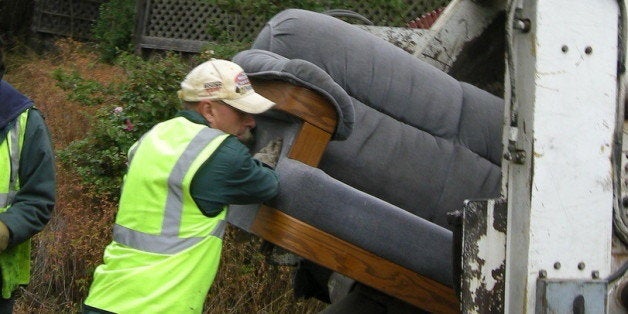
Arlene Blum was trekking in the Himalayas when new regulations to reduce the pervasiveness of flame retardants hit the books on Jan. 1 -- more than seven years after she began advocating the change and 37 years after she first published an article about health dangers of the chemicals.
California's new Technical Bulletin 117 removes a decades-old requirement that flame retardants be included in the filling of upholstered furniture. The state rule, which became the de facto standard for the rest of the nation, meant use of the chemicals flourished for years nationwide, despite mounting evidence implicating them in neurological and reproductive disorders, and cancers. For all their ills, the chemicals may not actually slow fires.
"Right now, most people have harmful flame retardants in their homes and in their bodies," said Blum, a University of California, Berkeley, chemist. "And the chemicals don't serve a benefit.
"This is huge for the health of everybody in this country and for our environment," she said.
But a "huge problem" also remains, added Blum. "What happens to the tens of millions of toxic sofas and chairs and baby products in this country?"
Blum and other experts warned that no safe method currently exists for disposing of furniture contaminated with flame retardants. This problem will mount as people discard couches and chairs in the coming months as flame retardant-free options become more widely available. Manufacturers and retailers have one year to comply with the new flammability standard, which can be met without chemicals. The American Home Furnishings Alliance, an industry trade group, said there will be "little or no cost involved in switching to the new testing procedure."
Whether the jettisoned furniture ends up in a landfill, a low-income home, a college dorm room or recycled into another product, the junk may further harm public health, experts said.
"Now that we'll be turning off the tap on new toxic flame retardants in furniture, the next challenge is to find a safe way to dispose of our old furniture," said Blum.
Landfills are a poor option, in large part because of the potential for chemicals to leak. Jim Marxen, deputy director at the California Department of Toxic Substances Control, told The Huffington Post that his agency found no evidence that flame retardants are "leaving landfills or posing any kind of threat once they are buried."
Heather Stapleton, a Duke University chemist, said California's required chemical testing list doesn't include flame retardants.
"They are not testing for them," Stapleton said. She noted that research has found flame retardants leaching from landfills.
Marxen agreed that there's a need to find a "better way of handling this furniture than putting it in the landfill." He highlighted efforts to find ways to safely remove the chemicals so that the rest of the material could be recycled.
Some carpet padding is made from recycled flame retardant-infused foam -- another way the toxic threat can linger.
Given that the average piece of furniture lasts 30 years, many discarded items find a second or third home. This may pose an environmental justice issue.
Ami Zota, an environmental health professor at George Washington University, pointed to several studies that suggest poor communities are exposed to levels of flame retardants in household dust that are several-fold higher than other communities.
The reason for the disparity is not completely clear. Zota suggested a smaller home with poor ventilation and more furniture per square foot could be a factor. The neighborhood may play a role, too. Without enticing outdoor play areas, children may be more likely to stay indoors. Finally, the quality of the furniture can influence how much flame retardants contaminate a home. An older, worn sofa, for example, may leach more of the chemical than a new model.
"There is the concern about second- and third-hand furniture ending up in these communities," said Zota, who published a small study in September that found levels of two flame retardants in residents blood had declined since their ban in 2004. "But we are going to see exposures to flame retardants drop off, and because these populations have some of the higher levels, they're going to see even sharper declines."
College students may be another at-risk group. Their dorm rooms and shared apartments can be full of hand-me-down furniture. Plus, they tend to be at peak reproductive years. Research has shown that exposures to flame retardants in the womb may be particularly damaging to a developing baby.
"Right now, there are no easy solutions to this problem," said Zota, whose new home has been without living room furniture for four months in anticipation of the regulation change.
Furniture industry representatives, meanwhile, expressed less concern.
"There is no reason for consumers to dispose of old upholstered furniture any differently than other unwanted furniture. If it is in reasonably good condition –- without tears or excessive soiling –- we would recommend offering it to charity or a secondhand store," Andy Counts, CEO of American Home Furnishings Alliance, told HuffPost in a statement.
Blum, also executive director of the nonprofit Green Science Policy Institute, suggested swapping just the foam from your furniture, then storing the old foam in garbage bags in a basement until researchers develop tools to separate out the toxic chemicals. She said her institute plans to host a foam exchange party in February to educate consumers.
As for finding new flame retardant-free furniture, Blum recommended looking for the new "TB 117-2013" tag and asking retailers whether a specific item contains flame retardants. It may be best to wait a few more months to allow new products to arrive in stores and old stock to be sold out, she noted.
Randi Abrams-Caras of the Washington Toxics Coalition emphasized that the new regulation does not stop manufacturers from continuing to use flame retardants.
"It's terrific that there's no longer a law that requires them, but what we need is a law that says they can't be used," she said, pointing to such legislation under consideration in Washington state.
There's also no guarantee that future rules favoring the use of flame retardants won't be introduced and counteract current gains, Abrams-Caras said.
The National Fire Protection Association, an industry group, is working on its own open-flame standard for furniture. The association and other industry groups maintain flame-retardant chemicals are safe in consumer products.
Blum said she sees the challenges ahead. But it didn't seem that way at the start.
Blum was also hiking through the Himalayas in 1976, when a mail runner delivered proofs of her soon-to-be influential paper on the cancer-causing potential of one flame retardant, chlorinated Tris. A few months after the study was published, the chemical was banned from children's pajamas.
Twenty years later, Blum discovered the same chemical in furniture foam. Tests showed that other flame retardants filled her own couch and the blood of her cat, Midnight, who had been diagnosed with hyperthyroid disease. Although a link can't be proven, the condition had been nearly unheard of in cats until around the time flame retardants were introduced into furniture.
Banking on her success in the 1970s with kids' pajamas, Blum figured a few months of raising awareness would be enough to rid the chemicals from furniture, too.
"Naive me," she said. It took more like seven years to reach this week's milestone. "I thought the battle was won. Now I don't think it's anywhere near won.
"But being a Himalayan climber, no matter how hard mountains seem to be, you know to just keep putting one foot in front of the other and plod up the mountain," she said. "It's the same thing."

